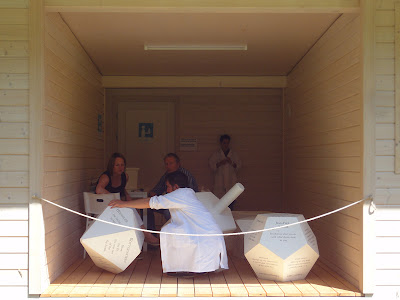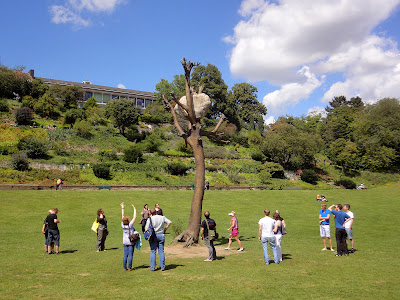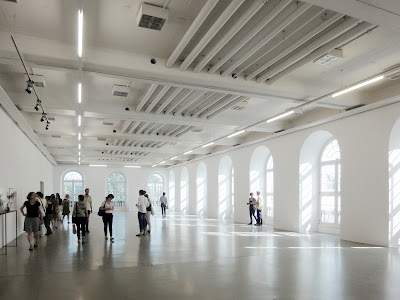dOCUMENTA (13) was massive. It took over the entire city, including various museums, theater, public plazas, park, and the train station, with artworks by 200 artists from 50 countries. The main outdoor venue was Karlsaue Park, a 1.5km² Baroque garden that accommodated more than 40 pieces of the show. To my surprise, many of these works were photographs and videos housed in little prefabricated wooden huts scattered around the park. It didn’t make sense in an open-air context where the sky’s the limit for public art like large sculptures and site-specific installations. Plus, videos and films are the format that requires concentration and patience. Very few people would actually watch them in their entirety, especially at a massive exhibition like documenta.
 |
| Joan Jonas’s hut for her video installation |
Some artists did take the concept of the freestanding hut and turned it into installations and even institutions. Japanese artist Shinro Ohtake attached objects and scraps onto a hut and made it a means of self-expression. Gabriel Lester created a curved tunnel to explore the moments of change and discovery. Mexican Pedro Reyes continued the Sanatorium he started for the Guggenheim’s Stillspotting NYC program. It was a utopian “temporary clinic” where visitors could sign up for free therapies for contemporary urban malaises: stress, loneliness, anxiety, etc. There were 8 sessions in the d(13) version of Sanatorium: the Museum of Hypothetical Lifetimes, Goodoo (the positive iteration of voodoo), Vaccine against Violence, Compatibility Test for Couples, Ex-Voto (to express gratitude), Philosophical Casino, Cityleaks, and Mudras (hand gesture expressions). Sam Durant’s subject was more intense. What looked like a playground pavilion or a viewing platform in the park was actually a reconstruction of multiple historically significant gallows, ranging from the Lincoln conspirators gallows to Saddam Hussein’s scaffold. They were stacked one on top of another and entangled within each other, forming a caustic anti-monument to the continuing history of death penalty.
 |
| Shinro Ohtake, MON CHERI: A Self-Portrait as a Scrapped Shed, 2012 |
 |
| Gabriel Lester, Transition 2012, 2012 |
 |
| Pedro Reyes, Sanatorium, 2011-ongoing |
 |
| Sam Durant, Scaffold, 2012 |
There were other more site-specific works that took the park context seriously. Located at the far end of the Hirschgraben, one of the two radial canals, a distorted clock was installed by Anri Sala to emphasize the Karlsaue Park’s central-point-of-view layout. On the other canal the Küchengraben, Swiss artist Christian Philipp Muller built a bridge with standard units of pontoons rented from the THW (the German Technical-Relief Organization), typically used to cross waters in post-disaster situations. On these long narrow barges, he placed potted soil beds of various colorful Swiss chard, turning the floating pontoons into a small farm.
 |
| Anri Sala, Clocked Perspective, 2012 |
 |
| Christian Philipp Muller, Swiss Chard Ferry (The Russians aren’t going to make it across the Fulda anymore), 2012 |
In the middle of Friedrichsplatz next to Karlsaue Park, Kristina Buch planted ideal food plants for indigenous butterfly species on a raised platform. Butterflies populated the flower island through the 100-day duration of d(13), and produced new butterflies, whose empty chrysalises were then collected by the artist and displayed in a glass vitrine at the entrance of the documenta-Halle. On the Karlswiese in front of the Orangerie, Chinese artist Song Dong created a 6m-high mound of lush tall grass and colorful flowers. The mound itself was nothing more then accumulated waste – layers and layers of rubble and biological garbage. Neon signs of Chinese characters on top said “Do for the sake of doing. Done for nothing. Do it even it’s for nothing.” Next to the mound, Massimo Bartolini embedded a rectangular pool into the grass. The water inside swayed rhythmically back and forth. There was obviously a mechanical system behind, but it still looked quite mysterious.
 |
| Kristina Buch, The Lover, 2012 |
 |
| Kristina Buch, The Lover, empty chrysalises |
 |
| Song Dong, Doing Nothing Garden, 2010-12 |
 |
| Massimo Bartolini, Untitled (Wave), 1997-2012 |
The highlight of Karlsaue was probably Giuseppe Penone’s tree on an open lawn. Barren branches were magically holding aloft a heavy boulder. This seemingly impossible situation drew a big crowd around it. Take a closer look, the tree was actually a hyper-realistic sculpture made from bronze. Installed back in 2010, it was the very first artwork of d(13). It had a sister piece in Kabul, where Penone permanently intervened the growth of a tree by cutting a marble piece into its trunk. The natural and artificial parts would integrate as a holistic entity.
 |
| Giuseppe Penone, Idee di pietra (Ideas of Stone), 2003/2008/2012 |


















































